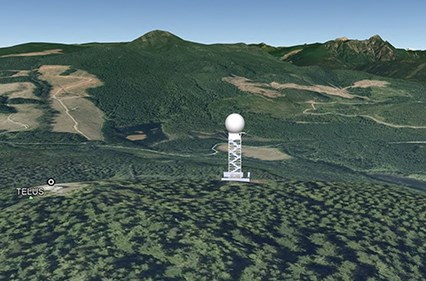A Canadian Weather Radar Replacement project planned for Halfmoon Bay would improve weather forecasting for the Sunshine Coast and the rest of southwestern B.C., according to the federal government.
The proposed installation will replace an already decommissioned BC Weather Radar site on Mount Sicker near Duncan on Vancouver Island. The project is part of a seven-year federal infrastructure initiative to upgrade the aging weather monitoring network with new radar sites across the country.
According to Pat Wong, senior advisor with Environment and Climate Change Canada’s Meteorological Service of Canada, these units give forecasters “a better picture of the sky,” which is one factor used in developing information on changing weather conditions.
Radar readings, partnered with inputs like lightning detectors and data collecting buoys, are used to provide advanced warning about severe storms, allowing potentially impacted residents and communities to take actions to protect their families and property.
The planned tower will allow for the detection of weather events within a 240-kilometre radius, including those approaching Vancouver Island from the west. That had not been possible with the Mount Sicker location.
Dual-polarization radar technology is to be employed at the site. This enables forecasters to better distinguish between rain, snow, hail, and freezing rain. Detection of extreme low-level winds, tornadoes and water spouts is another feature that will be enhanced with this upgrade.
The site selected for the installation is near Phare Lake. It is approximately 120 metres northeast of an existing 41-metre-tall Telus cell tower. The area around the new tower will be off limits to the public, secured by fencing and monitored by video cameras.
Wong said, “You won’t be able to see it from Sechelt or the highway. It may be visible from Sechelt Inlet, and would look like a tiny golf ball on top of the hill.” The proposal is for a 34-metre open lattice steel tower with an 11.8-metre diameter white radome at the top. The total height will be approximately 47.3 metres including lightning protection rods.
Public input on land use processes related to the proposal is being sought by the Ministry of Forests, Lands, Natural Resource Operations and Rural Development. Individuals have until Aug. 16 to send in comments or questions.
The Sunshine Coast Regional District (SCRD) has been requested to provide support for the ministry’s “request for concurrence” regarding the proposed land use. That issue was referred to the Advisory Planning Commission for Halfmoon Bay in June. At the July 15 SCRD planning and community development committee meeting, an APC recommendation that the board provide that support was received. The board is scheduled to receive a staff report and to consider that recommendation in September.
The project was scheduled to be installed in 2022. With the time required for the land use application process, a completion date for the installation has been adjusted to 2023. According to the project public notification package, it cannot be postponed further as no funding would be available in 2024.



